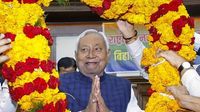In the aftermath of Bihar’s high-stakes state election in November 2025, India has found itself at the center of a controversy that stretches from the streets of Patna to the digital corridors of Kathmandu—and all the way to the heart of the country’s economic debate. Claims of electoral fraud, viral misinformation, and the spiraling costs of vote-driven welfare schemes have thrust the world’s largest democracy into a heated conversation about the integrity of its polls and the sustainability of its political promises.
The storm began brewing as soon as results were declared. The ruling Bharatiya Janata Party (BJP)-led National Democratic Alliance (NDA) claimed a resounding victory in Bihar, a state of 130 million people and a bellwether for national politics. Indian Prime Minister Narendra Modi hailed the win as proof that his economic policies were reaching even the country’s poorest citizens, according to AFP. Yet, the opposition Congress party and its allies swiftly countered with allegations of widespread electoral malpractice, igniting a war of words that soon spilled onto social media and into the public square.
On November 17, 2025, a video began circulating online purporting to show furious protests in Bihar after the vote, with claims that the BJP’s office in Patna had been set ablaze by angry citizens. The caption, in Hindi, read: “There was a huge uproar in Bihar over vote theft; the BJP office in Patna was set on fire.” Superimposed text on the clip challenged Prime Minister Modi, declaring, “This is Bihar, Modi ji, you have chosen the wrong state to steal votes.” The footage quickly gained traction on platforms like Instagram and Facebook, fueling rumors of post-election chaos and deepening suspicions about the legitimacy of the results.
But there was a catch—the video wasn’t from Bihar at all. A reverse image search by AFP revealed that the footage actually showed a house burning in Birgunj, Nepal, during the Gen Z protests that rocked the Himalayan nation in September 2025. The building belonged to Birgunj Mayor Rajesh Man Singh, and the video had been posted by local journalist Romi Raja Samani, who told AFP, “I recorded this video in September. It shows the Gen Z protests in Nepal. The house burning in the video belongs to our city Birgunj’s mayor Rajesh Man Singh. This has nothing to do with any political party in India.”
The protests in Nepal, which had nothing to do with Bihar’s elections, erupted after the government imposed a social media ban, sparking widespread anger over corruption, economic hardship, and rising violence. In just two days, at least 76 people were killed, including 63 protesters, 10 escaped prisoners, and three police officers. Crowds set parts of the parliament building and the Supreme Court on fire, ultimately bringing down the government. Yet, this footage was repurposed to stoke anger and suspicion in neighboring India, despite no official reports of widespread protests in Bihar following the election results.
While misinformation spread online, the Congress party doubled down on its allegations of electoral fraud. On November 27, 2025, Congress general secretary (organisation) K.C. Venugopal alleged that the Bihar Assembly election mandate was “managed, fabricated and deeply compromised.” In a post on X (formerly Twitter) after a four-hour review meeting with party leaders and candidates, Venugopal claimed the election was marred by “a distorted electoral process” rather than a genuine expression of voter will, as reported by IANS.
Venugopal detailed a series of complaints from candidates about voter deletions and last-minute additions, particularly through the State Identification Register (SIR). According to the Congress, the SIR was used to delete the names of traditional supporters while enabling “dubious additions.” Several candidates cited cases where voters found their names missing despite consistent documentation and having voted in previous elections. There were also allegations that funds from the Mukhyamantri Mahila Rojgar Yojana (MMRY) scheme were distributed close to polling day, which party leaders argued amounted to cash inducements—sometimes even near polling booths.
The Congress further pointed to what it called statistically unusual victory margins across numerous constituencies, suggesting a pattern that merited close scrutiny. Venugopal didn’t mince words in his criticism of the Election Commission of India (ECI), accusing it of acting “less as a neutral constitutional arbiter and more as an enabler of the ruling party’s strategy.” He asserted, “What happened in Bihar is a direct assault on democracy,” and vowed that the Congress would pursue legal, political, and organizational avenues to challenge what it called a “stolen mandate.”
Yet, while the opposition’s allegations captured headlines, another narrative was taking shape—one centered on the economic consequences of India’s new era of welfare politics. Two months before the Bihar state election, Prime Minister Modi launched a scheme to provide Rs 10,000 to one woman in every family in Bihar. In total, 1.2 crore women received this payment, a move widely credited in the popular imagination with driving up women’s turnout and securing the NDA’s landslide victory.
But as an opinion piece in The Indian Express pointed out, this narrative doesn’t quite hold up to scrutiny. The share of women voters in Bihar has been steadily rising for three decades, from 40% in 1995 to 50.4% in 2025. The increase in 2025 was not due to a sudden surge in women voters, but rather a decline in male voters—largely because of rising emigration by male workers. In fact, the percentage of women voting for the opposition alliance remained unchanged at 37% in both the 2020 and 2025 elections. There was no evidence of a mass defection of women voters to the NDA, nor of an abnormal spike in turnout.
What is beyond dispute, however, is the staggering cost of such welfare schemes. Bihar, one of India’s poorest states, spent Rs 12,000 crore on the cash transfer program—more than its entire annual health budget. This trend is not limited to Bihar: since 2023, at least 12 Indian states have introduced similar cash transfer initiatives targeting women voters, collectively costing Rs 1.7 lakh crore each year. As the opinion piece warned, “such huge sums of money to lure voters are not even the game-changers in elections as propagated. But this reckless election gamble by all political parties risks plunging the entire nation into economic and social ruin.”
With state governments’ total liabilities doubling in just five years, the fiscal strain is beginning to show. The more governments borrow to fund pre-election promises, the less money there is for critical services like education, health, and agriculture—ironically hurting the very families these schemes are meant to help.
As the dust settles on Bihar’s 2025 election, India faces a sobering reality. The contest for votes is not just about ballot boxes and campaign rallies; it’s also about the stories that go viral, the institutions that are trusted (or not), and the promises that come with a heavy price tag. The challenge now is to restore faith in the electoral process and find a way to balance democratic competition with long-term economic stability. The stakes, it seems, have never been higher.






